Related Research Articles

A petroglyph is an image created by removing part of a rock surface by incising, picking, carving, or abrading, as a form of rock art. Outside North America, scholars often use terms such as "carving", "engraving", or other descriptions of the technique to refer to such images. Petroglyphs, estimated to be 20,000 years old are classified as protected monuments and have been added to the tentative list of UNESCO's World Heritage Sites. Petroglyphs are found worldwide, and are often associated with prehistoric peoples. The word comes from the Greek prefix petro-, from πέτρα petra meaning "stone", and γλύφω glýphō meaning "carve", and was originally coined in French as pétroglyphe.

In archaeology, rock art is human-made markings placed on natural surfaces, typically vertical stone surfaces. A high proportion of surviving historic and prehistoric rock art is found in caves or partly enclosed rock shelters; this type also may be called cave art or parietal art. A global phenomenon, rock art is found in many culturally diverse regions of the world. It has been produced in many contexts throughout human history. In terms of technique, the four main groups are:

The Angono - Binangonan Petroglyphs are petroglyphs carved into a rock wall in Binangonan, Rizal, Philippines. It consists of 127 human and animal figures engraved on the rockwall probably carved during the late Neolithic, or before 2000 BC. They are the oldest known work of art in the Philippines. These inscriptions clearly show stylized human figures, frogs and lizards, along with other designs that may have depicted other interesting figures but erosion may have caused it to become indistinguishable. The engravings are mostly symbolic representations and are associated with healing and sympathetic magic.
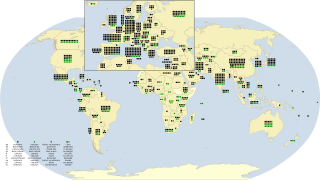
As of September 2023, there are a total of 1,172 World Heritage Sites located across 166 countries, of which 913 are cultural, 220 are natural and 39 are mixed properties. The countries have been divided by the World Heritage Committee into five geographic zones: Africa, Arab States, Asia and the Pacific, Europe and North America, and Latin America and the Caribbean. With 59 selected areas, Italy is the country with the most sites on the list; China is the second with 57 sites, and Germany is the third with 52.
Sarmishsay is located in the Karatau Mountain Range in the Nurata District of Navoiy Region of Uzbekistan. The gorge contains archeological remains dating back as far as the Stone Age, including two petroglyph sites with a total of 10,000 ancient rock carvings. According to UNESCO, it is the largest and most important rock art monument in Uzbekistan.
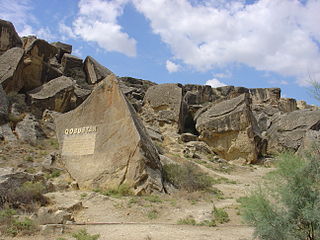
Gobustan State Historical and Cultural Reserve is located west of the settlement of Gobustan, about 40 miles (64 km) southwest of the centre of Baku. It was established in 1966, when the area was declared a national historical landmark of Azerbaijan in an attempt to preserve the prehistoric rock carvings, mud volcanoes and musical stones in the region.
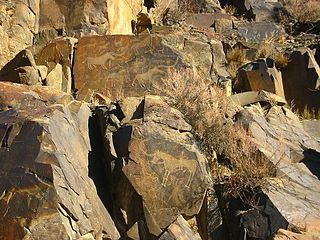
Tamgaly is a petroglyph site in the Zhetysu of Kazakhstan. Tamgaly became a UNESCO World Heritage Site in 2004. Tamgaly is located 170 km northwest of Almaty.

Saymaluu-Tash is a petroglyph site and a national park in Jalal-Abad Region, Kyrgyzstan, south of Kazarman. Over 10,000 carved pictures—and perhaps as many as 11,000—which are black-and-white rock paintings, have so far been identified, making the site a globally important collection of rock art. They are a sacred display of offerings of the ancient people of the lower valley.
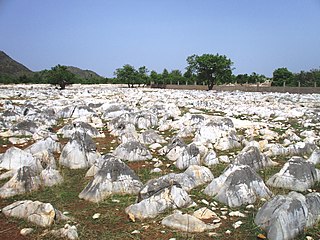
Bidzar is an archaeological site 20 kilometres (12 mi) from Guider, Cameroon, featuring petroglyphs between 3000 and 300 years old. The site, currently under threat from local cement and marble manufacturing operations, is being considered for inclusion in the UNESCO World Heritage list of sites with "outstanding universal value" to the world.
The Petroglyphs of Arpa-Uzen can be found in the Karatau mountain range of southern Kazakhstan.

The Rock Carvings in Tanum are a collection of petroglyphs near Tanumshede, Bohuslän, Sweden, which were declared a World Heritage Site by UNESCO in 1994 because of their high concentration.

Bir Hima is a rock art site in Najran province, in southwest Saudi Arabia, about 200 kilometres (120 mi) north of the city of Najran. An ancient Palaeolithic and Neolithic site, the Bir Hima Complex covers the time period of 7000–1000 BC. Bir Hima contains numerous troughs whose type is similar from North Arabia to Yemen.

Silk Roads: The Routes Network of Chang'an-Tian Shan Corridor is a UNESCO World Heritage Site which covers the Chang'an-Tianshan portion of the ancient Silk Road and historical sites along the route. On June 22, 2014, UNESCO designated a 5,000 km stretch of the Silk Road network from Central China to the Zhetysu region of Central Asia as a World Heritage site. The corridor spans China, Kazakhstan and Kyrgyzstan and includes 33 new sites and several previously designated heritage sites.

Vineyard Landscape of Piedmont: Langhe-Roero and Monferrato is the official name of a UNESCO World Heritage Site comprising "five distinct wine-growing areas with outstanding landscapes" plus the Castle of Grinzane Cavour in the region of Piedmont, Italy.

Rock Art in the Ha'il Region is the fourth site in Saudi Arabia to be inscribed on the UNESCO List of World Heritage Sites. The rock art includes two components situated in the desert of the Ha'il Region: the first is Om Sinman mountain at the city of Jubbah, and the second is al-Manjor and Raat at Al-Shuwaymis. An ancient population left traces of their passings in petroglyphs on the rock's surface, holding 8,000 years of history.

Qajartalik is a petroglyph site located on the Qajartalik peninsula of Qikertaaluk Island, Nunavut, approximately 40 km southeast of Kangiqsujuaq, Quebec. The site consists of over 150 carvings of faces in soapstone. It was created by the Dorset people, the culture who inhabited the Canadian eastern Arctic and Greenland beginning approximately 2,200 years ago before disappearing approximately 1,000 years ago, and who inhabited the region prior to the Thule Inuit who arrived approximately 800 years ago. It is believed to be the northernmost rock art site in North America and is considered to be one of a kind. The site is currently on Canada's tentative list of sites proposed for inscription on the UNESCO World Heritage List.
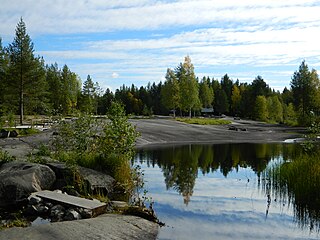
Petroglyphs of Lake Onega and the White Sea is a UNESCO World Heritage Site in Russia, Republic of Karelia, listed on 28 July 2021. The World Heritage Site comprises 33 petroglyph sites in two clusters. The rock carvings were created from 7 to 4 millennia ago and represent a glimpse into the lives of Neolithic cultures of Fennoscandia.